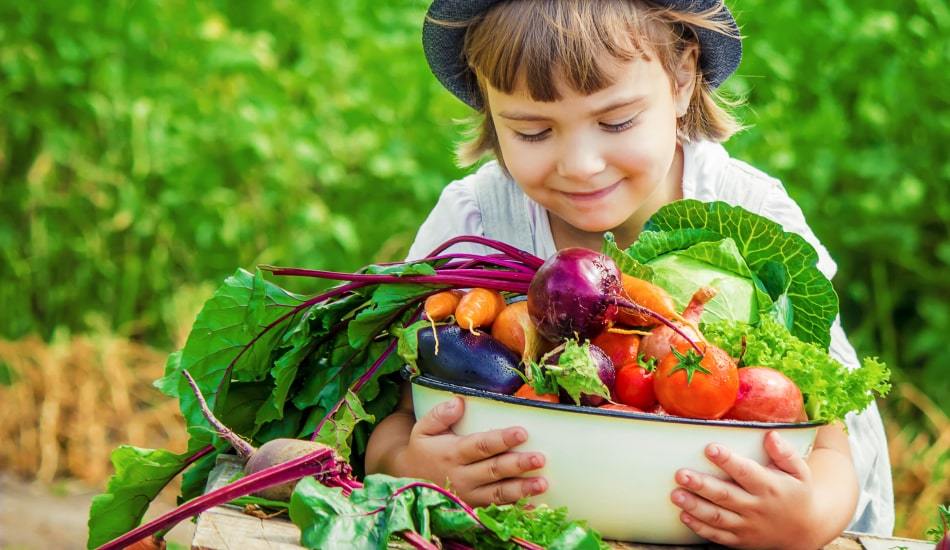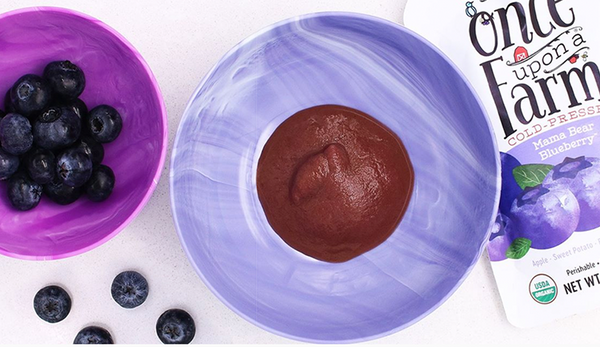How to Get Your Kids to Eat (and Love) Veggies

We all know that vegetables are good for us. However, if you’re like 90% of parents in the United States, you probably have a hard time getting your kids to eat vegetables. (1) Although we do live in a society where sugary and processed foods are more readily available and affordable than fresh, organic options and subliminal messages curated by not-so-healthy big food companies surround us and capture even the purest of palates, us parents have more influence than we think. Yep, we have the power to influence whether our kids decide to eat that piece of broccoli or leave it on the plate, awaiting the trash can or the dog’s mouth (or cat’s mouth if your cat is anything like mine).
If you want to learn how to get your kids to eat (and love) their veggies, read on for my top 5 tips!
1. Plant a Love of Veggies Early
If you plant the seed early, their love of veggies will grow. The biggest window of opportunity to influence taste preferences early in life is between 4 and 7 months of age (2), although our diets as mothers during preconception, pregnancy and breastfeeding also play a critical role. It is therefore important to introduce a variety of foods with repeated exposure to multiple types of vegetables during this time. Babies may be introduced to flavors in this window through either breastmilk, formula, solid foods or a combination of the three. The most important factor to remember in order to influence vegetable acceptance later on is repeated exposure. (3, 4, 5) This means creating as many veggie tasting experiences as you can with your little one. It doesn’t have to be a big taste either – a mouthful or two is all that’s needed! (6) Don’t give up if you interpret their face as one of disgust either as that’s most likely not the meaning behind it. Babies make all kinds of faces when introduced to something new so they don’t necessarily mean “I don’t like it.” It can take 10-15 tries to get them to accept a new food (here’s a bit more info about starting solids and introducing new foods!). (7)
Make sure to introduce vegetables by themselves to allow your baby to taste them in their pure state, but don’t be afraid to mix and match as well. Pairing vegetables with other foods has been found to increase children’s preferences for the taste of vegetables (8) but, on the flip side, it may have less positive impact over the long term (9). To cover all your bases, make sure to introduce veggies on their own as well as mixed with other foods, such as fruits, meat, spices, legumes, or grains to ensure you’re setting up the foundation for a veggie lover later on. Introduce a rainbow of colors such as beets, carrots, butternut squash, spinach, kale, broccoli, cabbage, and Brussels sprouts and get creative! If you’re short on time or just need a break, you can always grab a Once Upon a Farm pouch. We make sure to include veggies in every organic baby food blend.
2. Get Creative in the Kitchen
If you missed the early window, it’s not too late! It might just take a little extra work. As I previously mentioned, pairing vegetables with other foods can increase acceptance so get creative in the kitchen! Veggies can be incorporated into any dish – the possibilities are endless. Carrot Raisin Oatmeal anyone? Beet Pancakes? Or mix some spiralized zucchini in with their pasta primavera (and don’t forget the red bell pepper, fresh tomatoes and carrots in the sauce!). Spinach and apples work wonders for smoothies (or you can try our Appley Eating Greens cold-pressed smoothie if you need a break from making your own food). Lastly, don’t forget that simplicity can be so sweet – roasted Brussels sprouts with grass fed ghee or olive oil, for example is super yummy! Check out The Fresh Life for more fun recipes.
3. Make Food Fun
Kids love to play. And when it comes to food and play, we can encourage fun even more by getting creative with our vegetables. Try making “ants on a log” by placing peanut butter in some celery and topping with raisins or putting guacamole in there and topping with black beans. Scoop out a little bit of a baby tomato and stuff a piece of broccoli in there by the stem as another unique combo. Or simply make happy faces on their plates with green beans, tomatoes and raisins (or any mix of veggies you have on hand). These fun plates by Fred & Friends help turn eating vegetables into a fun game too!
4. The Art of Relativity
Kids love choice. As parents, we can set them up for successful choices by making those veggies seem like the most tempting item on the plate. One way to do this is by offering a variety of vegetables together. Results have shown that vegetables consumption increases when they are presented this way. (10) I believe this works because it gives them confidence to “choose” and suddenly that carrot might look super yummy relative to that piece of broccoli. Keep changing your variations up and see what they go for!
5. An Inch is a Cinch: The One Bite Encouragement
Be careful not to force your kiddos to eat anything. Research has shown that forcing our kids to eat can create negative associations with eating experiences and gets them to like that food even less. (11) Instead, encourage them to just take a bite. If they won’t do it, try offering a small reward such as a sticker. Non-food based incentives have been found to be successful in increasing children’s liking and consumption of previously disliked vegetables. (12) However, using other foods (such as a sweet food or dessert) as a reward should be avoided. Not only can it make that “sweet item” seem even more appealing since it’s being used as a “reward,” it can also send mixed messages. If we tell our kids they should enjoy nutritional, healthy foods but are making the end result of eating a less nutritious food more exciting and enjoyable, it can get confusing. I always have stickers on hand and suggest you do the same… even if your whole house ends up getting “decorated” with them.
Raising a veggie lover can definitely take some work in a society that bombards us with mixed messages around food but don’t give up, mama! Start early and if you don’t (or didn’t), start now! In twenty years when your no-longer-little-one reaches over and asks for more broccoli and is thriving in health, it will all have been worth it.
Sources:
-
“Vital Signs.” Centers for Disease Control and Prevention, Centers for Disease Control and Prevention, 5 Aug. 2014, cdc.gov/vitalsigns/fruit-vegetables/.
-
Beauchamp, Gary K., and Julie A. Mennella. Advances in Pediatrics., U.S. National Library of Medicine, Mar. 2011, ncbi.nlm.nih.gov/pmc/articles/PMC3202923/.
-
Ahern S.M., Caton S.J., Blundell P., HetheringtonM.M.Increasing pre-school children’s liking for a novel vegetable. A comparison of flavour-flavour learning and repeated exposure Appetite, 71 (0) (2013), p. 470
-
Birch LL, Marlin DW. I don’t like it; I never tried it: effects of exposure on two-year-old children’s food preferences. Appetite. 1982;3(4):353–360. doi: 10.1016/S0195-6663(82)80053-6. [PubMed][Cross Ref]
-
Sullivan SA, Birch LL. Pass the sugar, pass the salt: experience dictates preference. Dev Psychol. 1990;26(4):546–551. doi: 10.1037/0012-1649.26.4.546. [Cross Ref]
-
Cooke L (2007) The importance of exposure for healthy eating in childhood: a review. Journal of Human Nutrition and Dietetics20: 294–301.
-
Mennella JA, Nicklaus S, Jagolino AL, and Yourshaw LM. 2008. Variety is the spice of life: strategies for promoting fruit and vegetable acceptance during infancy. Physiol Behav. 94(1):29-38.
-
Remco, 2007. https://eetonderzoek.nl/wp-content/uploads/publikaties/havermans_en_jansen_appetite2007.pdf
-
Remy E, Issanchou S, Chabanet C et al. (2013) Repeated exposure of infants at complementary feeding to a vegetable puree increases acceptance as effectively as flavor‐flavor learning and more effectively than flavor‐nutrient learning. The Journal of Nutrition143: 1194–200.
-
Roe L, Meengs J. Serving a variety of vegetables and fruit as a snack increased intake in preschool children. Am J Clin Nutr. 2013;98(3):693–699. doi: 10.3945/ajcn.113.062901. [PMC free article][PubMed][Cross Ref]
-
Brown KA, Ogden J, Vögele C, and Gibson EL. 2008. The role of parental control practices in explaining children’s diet and BMI. Appetite. 50(2-3):252-9.
-
Remington A, Anez E, Croker H, Wardle J, Cooke LJ. Increasing food acceptance in the home setting: a randomized controlled trial of parent-administered taste exposure with incentives. Am J Clin Nutr. 2012;95(1):72–77. doi: 10.3945/ajcn.111.024596. [PubMed][Cross Ref]
Read More

Immune Boosting Foods
As many of us are spending more time at home...

Using Purees for Baby-Led Weaning
We’re so excited to partner with Whole Mamas for an...

Homemade Teething Biscuits & Frozen Yogurt Bites
Teething Biscuits Ingredients 2 cups of thick rolled oats 1...
